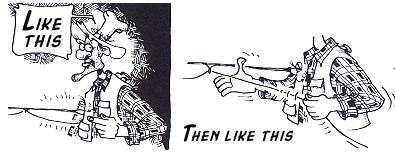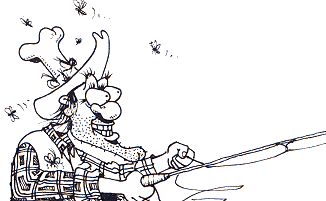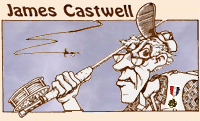|
Several years ago I spend many summer evenings fly-fishing for salmon. The Ladyfisher
and I would drive the twenty miles to an ocean beach known as Point-No-Point on the
Kitsap peninsula in north-western Washington state. The evening sunset over the water
of Puget Sound, the view of the majestic mountains, boating traffic, occasional arrival
of Dahl porpoise, wading out into the salt water, long-line casting for silver salmon, the
pain of cutting a grove in my index finger from stripping the line back in
after each cast. Ah, yes. I remember it well. But, no more.
My introduction to fly-fishing was dry fly in Michigan and Montana. No chance of
cutting my fingers while stripping a fly line using a number 18 dry fly. I would cast
right handed and strip the line in with my left hand.
After we moved here I used the same style of line retrieval. I did change how I held
the rod though. It was important to keep the rod tip low and pointed at the fly line.
When a salmon took, I would 'line-strike' with my left hand. That gave
a solid and direct connection to the fish without any flexing of the rod. This results in
solid hook-ups, or if missed, the fly does not rip itself out of the target zone as it would
do if the strike were done with the rod tip. I still use that method to this day. However,
I have changed how I strip the line in.
There are basically three methods that I use. First is the 'normal' way.
I cast out about as far as I can, using the double-haul, lower and point the rod at
the line, run the line over the first joint of my index finger of my right hand and pull
the line in using short tugs with my left hand. This move causes the left hand to work
back-and-forth across in front of me. This I can do for only a short time
as the fly line would soon cut my finger. This is because the line would be going
around a 90 degree bend at the joint. Remember, the tidal movement
and wave action has a pull on the line causing some resistance to the line retrieval.
Soon, a cut will form. In salt water not a nice thing to have.

A very acceptable substitute is used by many, I will here call it the
'rod-under-the-right-arm' method. It is by no means my idea, as it has
been used for decades world wide. After the cast I put the reel and grip of the rod
well under my right arm, hold it there with arm pressure, direct the rod at the line by
body motion, and strip the line in using both hands. A bit like a
hand-over-hand motion. Using this method there is no bend whatsoever
in the line and I always have at least one hand on the line at all times. When a fish hits
I line strike and simply with my right hand grab the rod and the game is on. A very
effective method of line retrieval.
 The third way of getting the job done is a major modification of the
'normal' method. I will try to make this as clear as possible. I have just made a
right-handed cast. I lower the rod tip and point it directly at the line, removing all
the slack and start my retrieve as normal. But here is the modification. I move
my right hand with the rod across my body to my left, while still keeping
the rod pointed at the line. At this time my rod hand is in front of me, about in
line with my left jacket pocket.
The third way of getting the job done is a major modification of the
'normal' method. I will try to make this as clear as possible. I have just made a
right-handed cast. I lower the rod tip and point it directly at the line, removing all
the slack and start my retrieve as normal. But here is the modification. I move
my right hand with the rod across my body to my left, while still keeping
the rod pointed at the line. At this time my rod hand is in front of me, about in
line with my left jacket pocket.
The line is still across my right index finger, but by stripping now with my left hand
I am able to use a motion that is from front-to-back along my left side. The angle
of fly-line on my finger has been reduced to perhaps ten degrees at the most. It is
possible to reduce the angle to zero if you desire. Certainly not enough
of a bend to cause any line cutting. I also find I rotate the rod a bit clockwise while
doing this, seems to make the retrieval easier.
Before I came up with the'Castwell-switch,' I tried putting
band-aids on my fingers only to have them roll up and soon fall off. Special gloves
to not excite me. And the neoprene fingers which are available for this are also
a nuisance, I made some and tried.
I have used this method for years not only on salmon but on other specie of fish
which are large and require a line-strip action to the fly and I never have any
problem with cut fingers. It should be obvious you need to keep your fly-lines
as clean as possible to avoid any 'sandpaper' action of a dirty line. I hope
this will help; works for me. ~ JC
|







